
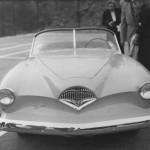
Here’s A Picture of The Kaiser Darrin Prototype. Photo Courtesy of Ron Kellogg of Kellogg Auto Archives.
Hi Gang…
We’re on a quest. A Kaiser-Darrin history quest. When did the Darrin sports car debut? And….when did it officially become the Kaiser Darrin 161 sports car? Inquiring minds want to know.
I know we can look it up in a book – if we’re lucky. But…. What Rick and I are finding is what has been written down often is not supported by the record of fact. Hence.. it’s down the research path we go to help validate and bring confidence and accuracy to the genre of early fiberglass sports cars.
You see, we’re creating a timeline – month by month – of significant events in fiberglass history starting at the big bang – November 1951. This is when the first 4 production/prototype fiberglass sports cars debuted at the Petersen Motorama to an adoring and excited public. Creating a month by month timeline from November 1951 thru 1957 should allow us to show the excitement and synergy of the era– and the variety and breadth of fiberglass cars that debuted in such a small window of time.
And the Darrin Sports car of 1952 was in the middle of all these activities.
Pinning Down the Fiberglass Timeline:
The more I look at the Kaiser Darrin Sports Cars, the greater I appreciate its size, dimensions, style, and grace. There were even differently designed hardtops available that accented the car’s grandeur in every way. Who couldn’t appreciate such a nicely designed sports car – and one of the first production fiberglass sports cars in the world? Count me in as one of the Kaiser Darrin’s biggest fans.
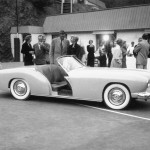
Another Publicity Photo Taken At The Debut of The Darrin Sports Car. Courtesy of Ron Kellogg of Kellogg Auto Archives. Thanks Ron!
With the help of several folks from the Kaiser-Frazer club (Jack Mueller, Terry Trasatti, and Tom Wilson), as well as other Kaiser Darrin enthusiasts such as Darren Swanson, we’re in the process of verifying exactly when the Kaiser-Darrin announcement was made, and when the official production car was available to the public. And the greatest interest points of interest to me have to do with the creation, design, and debut of Darrin’s car – before it became the Kaiser Darrin.
I thought we recently identified the first date that the “Darrin Sports Car” was about to become the “Kaiser-Darrin Sports Car” and this was in a recent story concerning the Kaiser Darrin and the magazine “Pic.” Specifically, this magazine showed a Kaiser Darrin on their front cover in their January 1953 issue. This magazine was courtesy of Tony St. Clair and his magnificent research skills and magazine collection. Thanks Tony!!! Click here to read the story about the Darrin and PIC Magazine.
The Four Cylinder Club of America:
Today’s article is a collaboration between myself and good friend Bill Wilkman who runs the website http://www.fourcylinderclubhistory.com/ Bill has been dedicating himself to documenting and preserving the history of this club – a club his father had belonged to back in the day.
And…. it should be noted that a lot of the original builders of our coveted fiberglass specials belonged to local chapters of this national organization many years ago, and built cars which included the most famous Byers SR100 in the world built by Ed Fort in Los Angeles, California. For those of you wishing to learn more about this club, please visit Bill’s website at the following link: http://www.fourcylinderclubhistory.com/
So why the grand introduction? I think it’s necessary to provide the context in which each of these “finds” is identified. By doing so, We can create an opportunity for each of you to jump along side of Rick D’louhy and myself and enjoy the ride of putting the pieces of the history puzzle back together again.
Today’s article appears in the second issue of the new magazine for the “Four Cylinder Club of America” called “Exhaust Notes.” This magazine was on the doorstep of some of the best known designers on the West Coast at the time – including Dutch Darrin. The amount of information hidden about sports cars – and their fiberglass brethren – is breath-taking.
As you’ll see, it was “Dutch” who gave the scoop or news to a young woman reporter/enthusiast of the Four Cylinder Club for distribution before anywhere else in the country. It might have been premature, but here are pictures of the car with its ultimate manufacturer identified in a magazine for the very first time. Pretty impressive gang.
So we have it for now – the Darrin Sports Car was officially (or secretly) introduced to the American public as the “Kaiser Darrin Sports Car” in November, 1952, and our crack research team identified above will continue to see what we can do to push this official announcement date back even further. In the future we’ll be identifying the exact date of the release of these cars to the public (the official announcement was made on February 22, 1953 – more about that in a future story here on FF.)
Thanks to each of the folks for their help with this mini-project. And now….off we go to the article – the introduction of the Kaiser Darrin Sports Car.
Exhaust Notes, November 1952
Four-Cylinder Club of America
The Darrin: K.F.-X.P.
By Dora Hutchison – Glendale, California
Scoops, my dears! Imagine little ol’ me getting a story ahead of “Life,” “Look,” “Pic,” and “Peek”; and that, dear readers, is just what this correspondent has done! At a secret rendezvous (Ciro’s) uner the cover of black velvet and sequins, and with a brace of martinis under my well-cinched waist, I did my best to look coy, innocent, and as if I “really didn’t care” while I pounced on my prey faster than Louella Parsons can say Hedda Hopper.
My prey was none other than Dutch Darrin, the man who built the Darrin Packards, and whose shop built “the most expensive bodies in the world” in Paris, before the war. For the past seven years he has been the design consultant for Kaiser-Fraser, Inc., and his latest achievement is the new Kaiser-Fraser sports car, the Darrin K.F.-X.P. This is definitely a car to impress ex-boyfriends with; and it comes in a four-cylinder model!
It will not be on the market until some time next year though, and Dutch told me Mr. Kaiser is reluctant to release any information until that time, but I batted mascaraed eyelashes, and smiled at him sweetly; what he told me follows.
The Darrin, as low and as racy as anyone’s dream car could be, has a fibreglas body (made by Glasspar, of Pasadena (sic)); in fact the whole car, except for frame and engine, is made of this plastic. Fibreglas has many advantages, besides high strength and low weight; if it is dented, or badly torn, the piece affected is cut out, and a slightly larger piece glued in its place; just like mending a torn lace dress!
Smooth off the rough edges, and paint it carefully – the dent has never been, and the whole job takes about an hour. Now some of the duller but essential details: The Darrin is built on a Henry J chassis, and uses Henry J parts throughout, including steering wheel, horn ring, and brake, clutch, and accelerator pedals (you can drive in high heels now, girls, without nearly breaking an ankle when you try to show that boy next to us at a light that you can drive fast even though you have bleached hair!)
Column shift, three speeds ahead, with overdrive optional; pistol-type emergency rake between driver and passenger seats; ashtrays and cigarette lighter are standard. The Darrin will have either the Henry J four or six cylinder engine, and there are tentative plans to have them available in varying stages of tune.
If not, arrangements will probably be made with one of the speed equipment manufacturers to make special heads, manifolds, exhaust systems, available to purchasers wanting more power. Through the car appears so extremely low, ground clearance is normal, and all parts of the engine are accessible (no stethoscopes, or curved dental mirrors are necessary.)
And, of course, the advantages of a low maintenance, low rpm American engine for long trips, or for parts of the country where there are few foreign cars are obvious. You won’t need to get your hands (and clothes, and face) dirty explaining to service station operators just how to change oil, or drain the radiator, and the long discussions necessary before it goes on a lube rack will be no more.
Aside from all this, not having to explain the shift pattern to every friend that wants to take the car around the block “to see how it runs” will be a relief, as well as less gear shifting in traffic (oh, my blistered hands), thanks to the high torque engine.
The final points in convincing a friend who has always wanted a sports car, but will….. will be the cost: $2850, and the choice of any or all of the Kaiser-Fraser colors. The dash is very simple, instruments in a level row, including oil temperature gauge (one excuse now for not letting the car warm up), as well as tachometer, speedometer, oil pressure, water temperature, ammeter, and gas gauge.
But, though I did my best, wiggling my fringed skirt when we rhumbaed, and putting on more perfume (“Joy,” of course), in the ladies’ room, I couldn’t wheedle any more details out of Dutch.
He said that the car had not yet been tested for top speed and acceleration; the one thing I did find out, after much hard work, was that, in spite of the apparently too small radiator opening, the car runs cool in traffic, and he is working on a way to block this off (from the driver’s seat) so the engine will not run too cold cruising at high speeds.
Looking at the car from the outside, after my eyes were used to the long, clean lines, and the absence of chrome, the first thing I noticed were the bumpers, molded into the body so cleverly that they seemed to be part of it, and I had to touch them to make sure they were steel.
Aside from looks, this will make parking easier; it will be impossible to snag another car, and leave a scratch along the side, or for another car to back into you and hook its bumper so that it takes four mechanics to get either of you free.
Then I noticed the headlights, frenched in the best Barris Kustom Kar tradition, and the wide smooth rear deck, which , when Dutch opened the trunk lid, had all kinds of room inside, in spite of the spare sitting in its well in the floor.
Anyway, the Darris is a very beautiful car; it is a true sports car (as opposed to wire-wheeled convertibles calling themselves so); and it is the first one in mass production in America to sell at a popular price. (I dug up the specifications on the Henry J from road tests, etc., in back issues of various motor magazines, but, when I asked Dutch if I could use them, he said: “Better not, it might look as if I’ve talked out of turn!”
Judging by the Henry J, the Darrin should be a fast car, with plenty of acceleration, and good road-holding qualities, but with the soft ride, and interior comfort of a typical American sedan. It is a car that anyone should be very proud to own, and I’m sure that, even after they are in common use, passers-by will turn and stare when one goes by, and say: “Gee, that’s smart! Wish I had one.”
Summary:
So there you have it. Our earliest announcement ever – with pictures to boot – of the car that was about to become the Kaiser Darrin Sports Car.
And…what makes this article even more interesting for me is that it was written by a woman. It’s the first article I can recall being written about a fiberglass sports car by a woman, and she did a great job. Her perspective and thoughts on the car – as you’ll see – are uniquely and positively feminine, so it’s an interesting view of the female perspective of these cars from the golden era of sports cars. Really cool!
Hope you enjoyed the story, and until next time…
Glass on gang…
Geoff
——————————————————————-
Click on the Images Below to View Larger Pictures
——————————————————————-
- asdfasf
- asdfsf



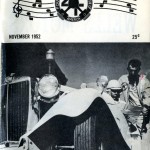
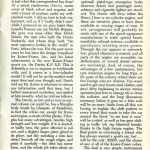
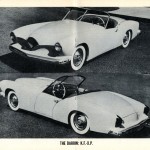
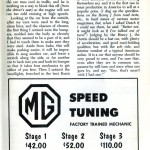



Here is another interesting tie-in to the K-D 161; Arrow Development of Mountain View, Ca, built over 50 miniature Kaiser-Darrins for publicity use. It also looks like the Kaiser Darrin may have had some influence on the styling of the Midget Autopia cars at Disneyland; http://arrowdevelopment.blogspot.com/2014/07/the-kaiser-darrin-jr-inspiration.html
Geoff,
Great find and interesting article. If Dora was able to get this published in November of 1952, she must have cornered Darrin at or just after the Peterson Autorama, where it was supposed to be displayed. – With all of the research I have done, I still haven’t found the original and “intended” producer of the car. Darrin had funding lined up before Kaiser saw it and agreed to build it (again, another story).
This article is the first I’ve seen in which a 4 cylinder engine was mentioned. By the time the car went to production, the Henry J, L-Head (4 and 6) engines were off the table and the Willys F-Head six was used. It only produced 10 HP more than the L-Head six used in the Henry J’s though. 🙂
Great story about a great story!
I love it when we can add some cool information to a body of knowledge that we’ve had 50 years to explore.
Can’t wait to see your timeline, Geoff. Please make it visual so it can resonate with visual learners like me.
—Todd Ruel
http://www.goneautos.com